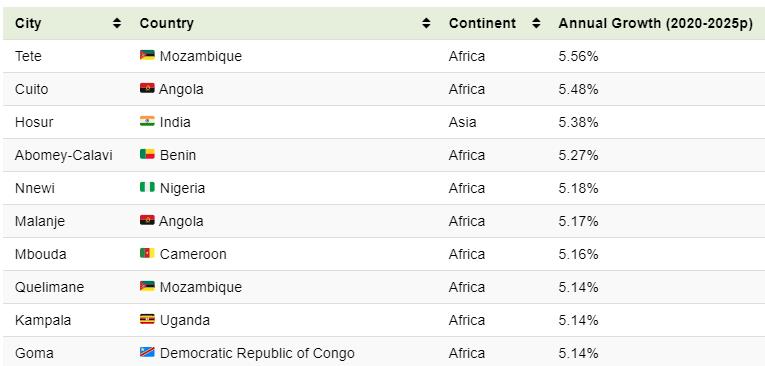(MENAFN- NewsIn.Asia)
August 25 (Visual Capitalist/Avery Koop) – Most of that population growth will be concentrated in cities across Africa and Asia. To help paint a detailed picture, this map uses data from the United Nations to rank the top 20 fastest growing cities in the world in terms of average annual growth rate from 2020 to 2025.
Subscribe to our Whatsapp channel for the latest updates on the news you need to know
Full Speed Ahead
The majority of the world's fastest growing cities are located in Africa—in fact, 17 of the 20 are located on the continent, with four of the 20 cities being located in Nigeria specifically.
Population growth is booming across the entire continent, as many countries retain high birth rates. According to the World Bank, the 2019 fertility rate (births per woman) in Sub-Saharan Africa was 4.6, compared to the global fertility rate of 2.4.

Table – Visual Capitalist

Table – Visual Capitalist
Nigeria's economy is largely based on petroleum which has resulted in the country becoming one of the strongest economies in Africa. This, coupled with a high birth rate and a resulting young population, has given the country a strong and rising workforce.
However, the population growth in Nigeria is both a blessing and a curse. The success of the economy, among other factors, has resulted in excessive rural-to-urban migration. This mass exodus from rural areas has led to less farming, which means the country now needs to import basic food staples at a high cost.
In Mozambique, Tete and Quelimane are growing 5.56% and 5.14% respectively. The country is expected to experience strong economic growth after facing contractions due to the pandemic. Forecasts predict that the Mozambiques's economy will grow 4% by 2022.
Implications of Fast Growth
All of the top 20 fastest growing cities are located in either Africa or Asia, and they are far outpacing growth on other continents, such as Europe, for example.
Fastest Growing Cities: Europe vs. Global

Table – Visual Capitalist
By 2050, Sub-Saharan Africa will be home to close to 2 billion people and roughly half will be under the age of 25. This represents an enormous labor force and opportunities for innovation and growth. In fact, in navigating the pandemic, Africa is already starting to capitalize on digital advances in both traditional and new sectors.
China has its eye on Africa, as evidenced through their multiple investments in infrastructure projects in the continent. Additionally, NATO countries have recently committed to investing similar amounts in Africa to counter China's influence.
In spite of the economic potential, increased city sizes could be problematic for some of these countries. They will need to adapt to the issues associated with mass urbanization, like pollution, overcrowding, and high costs of living.
Changing Tides
Population booms can lead to massive economic growth, a larger (and younger) working population, and a growing domestic consumer market.
As the aforementioned cities continue their rapid expansion, and as people continue to flock to growing megacities in Africa and Asia, it could represent the beginning of an important economic shift that is worth keeping an eye on.
For similar articles, join our Whatsapp group for the latest updates. – click here
Cities Growth Rank World
MENAFN25082021000191011043ID1102677749
Legal Disclaimer:
MENAFN provides the information “as is” without warranty of any kind. We do not accept any responsibility or liability for the accuracy, content, images, videos, licenses, completeness, legality, or reliability of the information contained in this article. If you have any complaints or copyright issues related to this article, kindly contact the provider above.